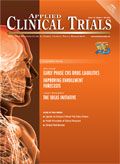Breaking Down Clinical Barriers
Applied Clinical Trials
The statistics show that fewer and fewer physicians are willing to take part in trials and that around half of those that do so once never do so again.
I recently wrote a response to consultation around the European Commission's proposed revisions to the Clinical Trials Directive. In the spirit of open debate, here it is, based on my experience as a physician working in the pharmaceutical and contract research industry for the last 22 years. I have been involved in many—probably over a hundred—clinical trials reasonably directly, in all phases and in almost all therapeutic areas, globally. The commentary is focused on the UK and EU legislation, but as you can see in the first sentence, the issues are global.

To my mind, barriers to clinical trials are in fact not specific to the United Kingdom or the European Union—although we have our specific elements as well, of course. We are still too expensive and too slow, but I believe these are well understood by the committee and are seriously addressed in the new Clinical Trials Directive which is clearly designed to reduce bureaucratic workload in lower-risk studies/trials. I have to question, however, if these are indeed the main barriers to research, as most of the pivotal and core trials for new chemical entities (NCEs) and biologicals will still fall into the high workload categories, and be unaffected by most of the changes proposed.
The statistics seem to show that fewer and fewer physicians are willing to take part in trials and that around half of those that do so once never do so again. This is compounded by a reduction in patient retention in trials, making them hard to predict and more financially risky projects. In turn, this limits Western trial sites to around 6% of all possible investigators, and in that figure, a reducing number of patients are willing to stick with a trial for long enough to get a reasonable result to see if the NCE works. To make a major impact today on trial participation, I feel these issues must be addressed.
There is a trend in the industry at present that is focusing trials into fewer and fewer sites and opening up access to patients without recruiting a physician in a site to look after them. These so called "virtual" studies are attempting to allow access to trials to many more patients and to reduce the required number of sites to look after them, while still maintaining the safety of the patient and the integrity of the data. I believe the ability to achieve these goals is within our grasp, and with the increased orientation of trials to be more patient-centric regarding the motivation of patients to take part, we have a set of drivers that can truly turn around the crisis facing the whole sector today.
The EU directives need to start to look at how to support trials that allow many more patients access. They also need to look at reducing the complexity of informed consent documents and data protection documents. Furthermore, they must continue to reduce cross border delays in trial logistics (critically with regions outside of the European Union), and they should introduce changes designed to allow greater integration of the routine, non-trial related healthcare professionals who continue to look after the patient locally during the trial. These professionals are kept essentially in the dark on any details, without having to have them formally delegated to the investigator, trained, QC'd, monitored etc.—all for little or no benefit to the actual health management of the patient and with little or no risk to the data from the trial.
In a blog (http://bit.ly/17kgMN2) on the MRN website, I address another of the consultation's questions: How could the occurrence and results of clinical trials be made more open to scrutiny? Who should be responsible?
Graham Wylie, MD CEO, MRN, Ltd.
E-mail:[email protected]

FDA Fast Tracks Johnson & Johnson’s Nipocalimab for Fetal Neonatal Alloimmune Thrombocytopenia
March 27th 2024Johnson & Johnson is moving forward with a pair of Phase III trials of nipocalimab to reduce the risk of fetal neonatal alloimmune thrombocytopenia in alloimmunized pregnant patients.
Citius Pharmaceuticals Resubmits BLA to FDA for Lymphir to Treat Cutaneous T-Cell Lymphoma
March 19th 2024Pivotal Phase III Study 302 trial data show an objective response rate of 36.2% based on an independent review committee assessment in the treatment of relapsed/refractory cutaneous T-cell lymphoma.